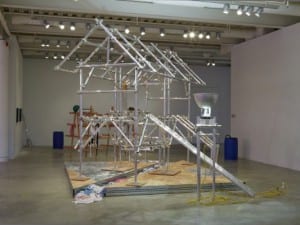Currently occupying the main space in Portsmouth’s Aspex Gallery is EMERGENCY, a group exhibition showcasing the work of 10 early-career artists. The biennial open submission exhibition invites submissions from emerging artists working in all media. From nearly 400 artists, ten were chosen to exhibit their work by a panel including artist Suki Chan; Karen Mackinnon, Director and Curator at Artes Mundi; Kwong Lee, Director of Castlefield Gallery; and Joanne Bushnell, Director of Aspex Gallery.
From this shortlist of 10, one overall winner was chosen. British artist Maya Ramsay was awarded prize money of £1,000 and a solo exhibition at the gallery in Spring 2017. Ramsay’s Wall of Sound project consists of graphite rubbings on manuscript paper of the woodchip wallpaper at Jimi Hendrix’s London home in Mayfair. These rubbings look curiously like musical notation, and this ‘wallpaper score’ will be performed at the opening of the Hendrix museum on 13 February 2016.
The other submissions in the exhibition include Steve Moberly’s Hoodies in Trenches, two colourful and fluid paintings (acrylic on polyester), whose oozing figures both repel and delight. Alison Carlier’s Tonal Observational Drawing is a spoken recording of a description of different types of wood, enabling the listener to close their eyes and create their own internal visualisation of what is being described. Tim Simmons also explores sound; specifically, what happens at latitude 42.97, the point at which the speed of sound and the speed of the Earth’s rotation is the same, in his video installation 42.97.
Other artists have explored themes of identity and the environment. Euan Gray’s Destinations to Die For looks at how the tourism industry exploits the current trend for visiting assassination sites. Jane Lawson presents an artefact with accompanying video footage in Capitalism and Freedom After Detoxification. The installation shows how oyster mushrooms, which can detoxify a range of poisons including hydrocarbons, warp the pages of a copy of Milton Friedman’s book Capitalism and Freedom over time, and is a clever and original comment on the need to clean up a system that still relies on fossil fuels. Laura Malacart’s The Little Book of Answers is a series of digital prints based on pages from an artwork of the same name, featuring answers from the UK citizenship test. In July the book was the basis for a one-day multi-layered participatory performance event that took place in the Turbine Hall at Tate Modern, London.
Rita Evans’ intriguing installation Wool Matrix explores how improvisation and creativity can come from turbulence. Caroline King’s digital animation Peripheral Visions features photographic images of predominantly her own artwork, showcased in an erratic looped sequence that plays with how our brain interprets material in a visually saturated world. Chris Shaw Hughes’ carbon drawings could easily be mistaken for photographs from several paces back. His submission is a series of drawings featuring cities that have experienced destruction due to bombing: Hanover (Germany, 1945), View from St Pauls (London, 1945) and Gaza (Palestine, 2014). The drawings form part of a series of works depicting sites of trauma. The 10 submissions form a varied landscape of exploration and an intriguing taster of the work of these artists.
Jennie Rawling
EMERGENCY: 2015/16, until 11 January, Aspex Gallery, The Vulcan Building, Gunwharf Quays, Portsmouth, PO1 3BF.
For more information, visit www.aspex.org.uk.
Follow us on Twitter @AestheticaMag for the latest news in contemporary art and culture.
Credits
1. Rita Evans, Wool Matrix, 2015. Courtesy of Jennie Rawling.





